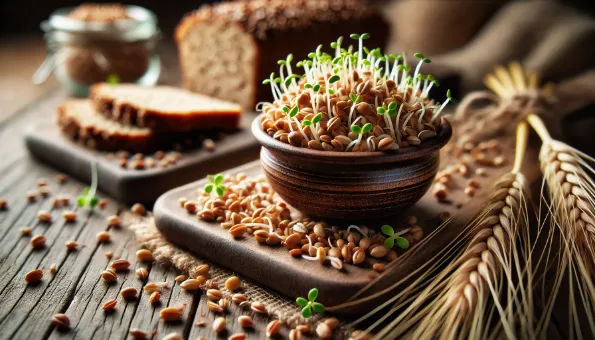Sprouted Grains: Softer Bite, Bigger Nutrient Punch
Soaking and germinating wheat, spelt or quinoa unlocks up to 3× more folate, reduces carb load and lends a gentle sweetness—without extra sugar.

Why Sprouting Changes the Game
When whole grains absorb water and **germinate for 24–48 h**, enzymes kick-start growth: starch breaks into simpler sugars, phytic acid declines and vitamins bloom. The result is bread and bowls that are easier to digest yet taste naturally sweeter.
Nutrition per ½ cup cooked (100 g)
|Calories|Protein|Fat|Carbs|Fiber|Iron|Folate|
|---|---|---|---|---|---|---|
|130 kcal|6 g|1 g|26 g|4 g|8 % DV|15 % DV|
Evidence-Backed Benefits
- **Lower glycaemic impact**: smaller starch molecules slow glucose spikes.
- **More micronutrients**: folate, vitamin C and antioxidants rise during germination.
- **Better mineral absorption** thanks to reduced phytic acid.
- Softer texture means **less need for added fats or sugars** in baking.
Possible Drawbacks
- Still contains **gluten** if sprouted from wheat, barley or spelt.
- Shorter shelf life—high moisture can mould; freeze bread within three days.
- DIY sprouting must be hygienic to avoid bacterial growth.
How to Use Sprouted Grains
- Swap 1-for-1 with regular cooked grains in bowls or salads.
- Bake **sprouted-grain bread** for a mildly sweet, nutty crumb.
- Toast sprouted oats for granola that stays crunchy longer.
- Blend sprouted buckwheat into smoothies for raw-food protein.
Buying & Storing
- Look for “**100 % sprouted whole grain**” on labels; some loaves mix with refined flour.
- Refrigerate fresh sprouted tortillas; freeze extras.
- Home sprouting: rinse grains twice daily, keep under 20 °C, cook or dehydrate within 48 h.
- 1. Sprouted Grains

